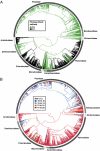Phylogenetic analyses reveal the shady history of C4 grasses
- PMID: 20142480
- PMCID: PMC2823882
- DOI: 10.1073/pnas.0909672107
Phylogenetic analyses reveal the shady history of C4 grasses
Abstract
Grasslands cover more than 20% of the Earth's terrestrial surface, and their rise to dominance is one of the most dramatic events of biome evolution in Earth history. Grasses possess two main photosynthetic pathways: the C(3) pathway that is typical of most plants and a specialized C(4) pathway that minimizes photorespiration and thus increases photosynthetic performance in high-temperature and/or low-CO(2) environments. C(4) grasses dominate tropical and subtropical grasslands and savannas, and C(3) grasses dominate the world's cooler temperate grassland regions. This striking pattern has been attributed to C(4) physiology, with the implication that the evolution of the pathway enabled C(4) grasses to persist in warmer climates than their C(3) relatives. We combined geospatial and molecular sequence data from two public archives to produce a 1,230-taxon phylogeny of the grasses with accompanying climate data for all species, extracted from more than 1.1 million herbarium specimens. Here we show that grasses are ancestrally a warm-adapted clade and that C(4) evolution was not correlated with shifts between temperate and tropical biomes. Instead, 18 of 20 inferred C(4) origins were correlated with marked reductions in mean annual precipitation. These changes are consistent with a shift out of tropical forest environments and into tropical woodland/savanna systems. We conclude that C(4) evolution in grasses coincided largely with migration out of the understory and into open-canopy environments. Furthermore, we argue that the evolution of cold tolerance in certain C(3) lineages is an overlooked innovation that has profoundly influenced the patterning of grassland communities across the globe.
Conflict of interest statement
The authors declare no conflict of interest.
Figures



Similar articles
-
Climate, phylogeny and the ecological distribution of C4 grasses.Ecol Lett. 2008 Mar;11(3):266-76. doi: 10.1111/j.1461-0248.2007.01144.x. Epub 2008 Jan 14. Ecol Lett. 2008. PMID: 18201200
-
C4 photosynthesis evolved in warm climates but promoted migration to cooler ones.Ecol Lett. 2018 Mar;21(3):376-383. doi: 10.1111/ele.12905. Epub 2018 Jan 10. Ecol Lett. 2018. PMID: 29318753
-
Global grass (Poaceae) success underpinned by traits facilitating colonization, persistence and habitat transformation.Biol Rev Camb Philos Soc. 2018 May;93(2):1125-1144. doi: 10.1111/brv.12388. Epub 2017 Dec 12. Biol Rev Camb Philos Soc. 2018. PMID: 29230921 Review.
-
The origins of C4 grasslands: integrating evolutionary and ecosystem science.Science. 2010 Apr 30;328(5978):587-91. doi: 10.1126/science.1177216. Science. 2010. PMID: 20431008 Review.
-
Fire and fire-adapted vegetation promoted C4 expansion in the late Miocene.New Phytol. 2012 Aug;195(3):653-666. doi: 10.1111/j.1469-8137.2012.04202.x. Epub 2012 Jun 20. New Phytol. 2012. PMID: 22712748
Cited by
-
Genetic Diversity of C4 Photosynthesis Pathway Genes in Sorghum bicolor (L.).Genes (Basel). 2020 Jul 16;11(7):806. doi: 10.3390/genes11070806. Genes (Basel). 2020. PMID: 32708598 Free PMC article.
-
Adaptation to seasonality and the winter freeze.Front Plant Sci. 2013 Jun 3;4:167. doi: 10.3389/fpls.2013.00167. eCollection 2013. Front Plant Sci. 2013. PMID: 23761798 Free PMC article.
-
V.PhyloMaker2: An updated and enlarged R package that can generate very large phylogenies for vascular plants.Plant Divers. 2022 May 27;44(4):335-339. doi: 10.1016/j.pld.2022.05.005. eCollection 2022 Jul. Plant Divers. 2022. PMID: 35967255 Free PMC article.
-
Understanding Past, and Predicting Future, Niche Transitions based on Grass Flowering Time Variation.Plant Physiol. 2020 Jul;183(3):822-839. doi: 10.1104/pp.20.00100. Epub 2020 May 13. Plant Physiol. 2020. PMID: 32404414 Free PMC article. Review.
-
CO2 availability influences hydraulic function of C3 and C4 grass leaves.J Exp Bot. 2018 Apr 27;69(10):2731-2741. doi: 10.1093/jxb/ery095. J Exp Bot. 2018. PMID: 29538702 Free PMC article.
References
-
- Hatch MD. In: Photosynthesis and Photorespiration. Hatch MD, Osmond CB, Slayter RO, editors. San Diego: Academic; 1971. pp. 139–152.
-
- Muhaidat R, Sage RF, Dengler NG. Diversity of Kranz anatomy and biochemistry in C4 eudicots. Am J Bot. 2007;94:362–381. - PubMed
-
- Christin PA, et al. Oligocene CO2 decline promoted C-4 photosynthesis in grasses. Curr Biol. 2008;18:37–43. - PubMed
-
- Sage RF. The evolution of C-4 photosynthesis. New Phytol. 2004;161:341–370. - PubMed
-
- Still CJ, Berry JA, Collatz GJ, DeFries RS. Global distribution of C-3 and C-4 vegetation: Carbon cycle implications. Global Biogeochem Cycles. 2003;17:1006.
MeSH terms
Substances
LinkOut - more resources
Full Text Sources
Other Literature Sources
Molecular Biology Databases
Miscellaneous

